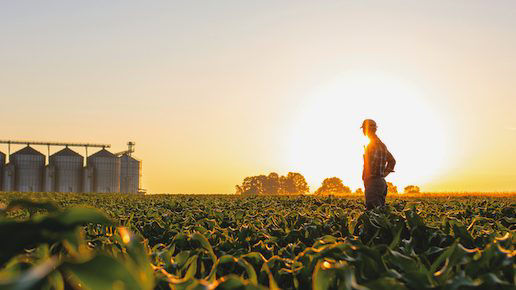5 READ-TIME
Farm Insurance: An Exercise In Risk Management
January 4, 2024

By Clare Stanfield
Do you know if your farm is over insured? Under insured? Farm insurance is kind of like the furniture — you see it every day, but you don’t really see it until something happens.
Cam Cervo, commercial account executive with Knight Archer Insurance in Chestermere, AB, gets that. “I wrote a couple of farms last week and they were under insured,” he says, explaining that these farmers had buildings they used all the time, but had not insured.
It’s not that the buildings don’t have worth, it’s just that the farmers didn’t see the value of insuring them. “As buildings get older, farmers often don’t want to insure them,” says Cervo. But if they lost those buildings to fire or hail or even vandalism, the cost to replace them — remember, these buildings are used every day — is definitely going to be higher than the premium paid to protect them.
Most farm insurance is sold in bundles or packages that cover your home, buildings, machinery, land and general liability. But packages can be tailored to fit your specific farm business, and a regular review of property and assets is key. “That’s what I always say to farmers: what’s the value and can you risk having to replace that?” says Cervo. “It’s all risk management.”
SWEAT THE SMALL STUFF
In an era of high inflation and high input costs, assessing the value of property and equipment can be a bit of a wild card. Gordon Ross is a farm and commercial specialist with the Co-operators in Saskatoon. He used to farm himself, running a cattle and grain operation near Swanson, SK, until his retirement in 2012. He started selling insurance in 1996 when he was farming, and now does it full-time.
“Machinery is the big one on farm policies,” says Ross. Equipment depreciates, yes, but not insuring older items to save money on premiums could be penny wise and pound foolish.
For example, says Ross, if you suddenly lost a tractor you paid $60,000 for a few years ago, and a replacement tractor is $90,000, maybe it’s worth a small premium to get something for that old tractor so you are not quite so much out of pocket buying the replacement one.

“As buildings get older, farmers often don’t want to insure them. But if they lost those buildings to fire or hail or even vandalism, the cost to replace them is definitely going to be higher than the premium paid to protect them”
CAM CERVO
COMMERCIAL ACCOUNT EXECUTIVE KNIGHT ARCHER INSURANCE
Cervo agrees. “Farmers don’t always insure their equipment in full,” he says, giving an example of a ride-on mower — something used a lot around the farm but not used to actually farm. “Maybe it’s worth only seven or eight grand to buy a new one, but it’s only $50 to $75 to insure it.”
He estimates every farm has somewhere between 20 and 25 pieces of equipment, not to mention tools. He even once had a farmer who had 100 uninsured cows, and all it took was a $50 premium to get them covered.
PAY ATTENTION TO LIABILITY
All farm policies come with liability insurance, yes, and that covers most accidents or incidents when someone is hurt on your property. But, Cervo says that farmers should ask if they have the right liability for the things they are allowing on their farm. “It’s very specific,” he says.

“It doesn’t take much to get sued for a million dollars. I’d recommend farmers change to the $2 million liability”
GORDON ROSS
FARM AND COMMERCIAL SPECIALIST THE CO-OPERATORS
Last year, Cervo had a client who offered hayrides and school tours on his farm. “He didn’t think he needed different liability coverage, but he did. I guarantee, if a small child is hurt on your farm, you’re going to get sued.” Cervo has another client who holds an annual barbecue for the people in his town — a beautiful thing to do for the community — but feeding a bunch of people on your property has inherent risks you might not be thinking of.
Cervo also mentions on-farm vehicles, like quads. “A ton of farmers use quads to get around their fields and don’t insure them,” he says. “But if they take that quad on a public road at any point, they are liable if something happens.”
“It doesn’t take much to get sued for a million dollars,” says Ross, adding that many policies are now increasing liability limits. “I’d recommend farmers change to the $2 million liability — it doesn’t do much to the premium, maybe 20 to 30 bucks.”
REVIEW BEFORE YOU RENEW
Ross and Cervo agree that it’s important to take the time to carefully review your insurance policy when it comes up for renewal. Look at your operation in depth — think about what you use, how you use it, how frequently you use it and what financial risk you’re willing to take if you lose it.
And don’t just renew without thinking, says Cervo. He has had clients who just go ahead and renew their policies, forgetting that they have sold some of the equipment they are insuring.
“I’d recommend everyone have a live spreadsheet,” he says. “It’s really not that hard. I have one farmer who does it ‘to a T’ — he has every piece of equipment on it, when he bought it, how much it cost, replacement cost —everything about it is recorded there.”
Farm insurance is definitely not a onesize- fits all proposition. From the 10,000- acre grain farm to the 10-acre U-pick to the 200-head dairy, Ross and Cervo say that policies are completely customizable to your operation and your budget. All you have to do is ask.
“I enjoy this work because, even though I wrote one farm today, the next farm will be totally different,” says Cervo. “I used to do direct writing for insurance companies, and the reason I switched to being a broker was to help farmers. I can give them three or four or five different quotes at a time — they get different price options for the same coverage.”
